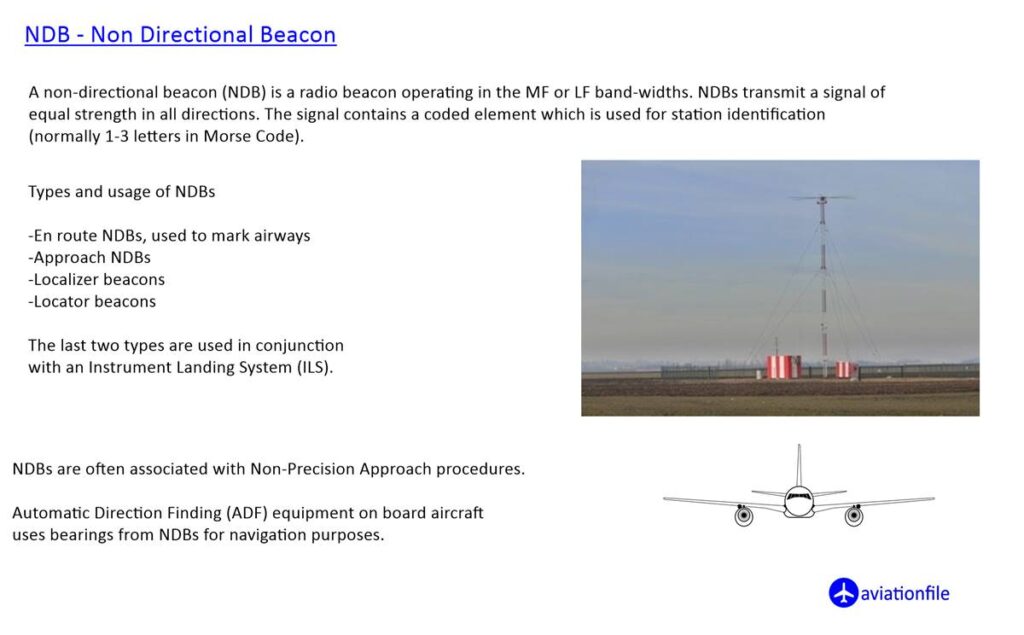Debunking Aviation Myths: What is a Non-Directional Beacon (NDB) Really?
In the world of aviation navigation, a multitude of systems guide pilots across the skies. Among these, Non-Directional Beacons (NDBs) hold a unique position. Often misunderstood, NDBs offer a reliable and complementary navigation aid, despite not providing direct course guidance. Let’s delve deeper into the truth behind NDBs. What is a Non-Directional Beacon (NDB) Really?
NDBs: A One-Way Radio Conversation
Unlike their directional beacon cousins, NDBs don’t transmit directional information themselves. Instead, they function as continuously operating radio transmitters on the low or medium frequency range. Imagine an NDB as a constantly buzzing radio station broadcasting its signal in all directions.
The Pilot’s Sidekick: The Automatic Direction Finder (ADF)
Aircraft receive these NDB signals using an Automatic Direction Finder (ADF). This onboard instrument acts like a special radio receiver that detects the strongest signal direction. However, the crucial point to remember is that the strongest signal points directly back to the NDB, not necessarily towards the pilot’s destination.
Think of it this way: Picture an NDB as a radio beacon at the center of a lake, and your aircraft on the lake’s surface. The ADF in your aircraft acts like a fancy compass needle. No matter where you are on the lake, the ADF will always point directly back to the beacon in the center, not towards the shore (your destination).

Beyond Misconceptions: The Enduring Value of NDBs
While NDBs might not offer direct course guidance like modern GPS systems, they remain valuable tools for pilots for several reasons:
- Bearing Determination: By referencing the direction indicated by the ADF, pilots can determine their relative position (bearing) to the NDB. This bearing information becomes a crucial piece of the navigational puzzle, especially when combined with other navigational aids or charts.
- Approach Procedures: Certain airports, particularly those in less congested areas, utilize NDBs for non-precision instrument approaches. These approaches rely on the pilot’s ability to determine their position relative to the NDB to navigate a safe descent path.
- Location Verification: Each NDB transmits a unique Morse code identifier. Pilots can use this identifier to confirm their location against aeronautical charts, ensuring they are on the correct course.
NDBs: A Reliable Partner in Navigation
In conclusion, NDBs serve as a complementary navigation system, particularly valuable for short-range navigation and approach procedures. While they may not be the sole source of guidance in modern aviation, their reliability and simplicity make them a trusted partner for pilots, especially when used in conjunction with other navigational tools.
Frequencing the Navigation Spectrum: NDB Signal Range
NDBs operate within a designated portion of the radio spectrum, allowing for clear signal transmission and reception. The International Civil Aviation Organization (ICAO) allocates frequencies between 190 kHz and 1750 kHz for NDBs. However, in practice, most NDBs in North America function within the 190 kHz to 435 kHz and 510 kHz to 530 kHz bands. European NDBs typically occupy the 280 kHz to 530 kHz range, with a gap between 495 kHz and 505 kHz to avoid interference with the international maritime distress frequency. By utilizing these specific frequencies, NDBs offer reliable navigation assistance while minimizing signal overlap with other radio broadcasts.
Resources and Further Reading Links:
- Federal Aviation Administration (FAA): Aeronautical Information Manual (AIM) Chapter 4 – Navigation Aids https://www.faa.gov/air_traffic/publications/atpubs/aim_html/ (Chapter covers various navigation aids, including NDBs)
- SKYbrary: Non-Directional Beacon (NDB) https://www.cfinotebook.net/notebook/avionics-and-instruments/non-directional-radio-beacon (In-depth explanation of NDBs with diagrams)
- AOPA Air Safety Institute: Automatic Direction Finder (ADF) https://www.aopa.org/ (Explains how ADFs work in conjunction with NDBs)
- https://www.systemsinterface.com/products/navaids/ndb
- https://www.mediawiki.ivao.aero


